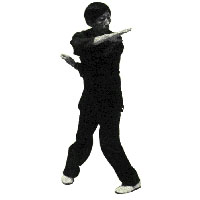By Francis Hriadil
While the tactics and techniques discussed in the previous article describe Pa Kua at an early age when it was used in serious life and death combat situations, those tactics and techniques do not strictly define Pa Kua Chang. Pa Kua Chang is an art that is based on principles and, as such, there is no strict definition of the art related to form or application. The art of Pa Kua adapts and changes as the circumstances dictate and it changes to a certain degree with each individual who practices the art. This is why Tung Hai Ch’uan taught each of his students differently and why every Pa Kua instructor displays a somewhat different interpretation of the art. It is not an art which is meant to be transferred exactly (i.e. copied) from the teacher to the student. Every student is unique and thus every student should be taught to develop his or her Pa Kua ability, according to the underlying principles, based on his or her own individual strengths and weaknesses. Additionally, each practitioner must take the principles of the art and apply them in ways that are best suited to the various combat environments of the day. If every student was taught in exactly the same way and only practiced the art in a well lit, smooth-floored martial arts school, for example, the training would not be natural nor would it follow the fundamental philosophical trinity.
Sifu Park Bok-Nam’s teacher, Lu Shui-Tian, required that he practice Pa Kua Chang in many different locations and environments. Sifu Park was required to practice in the martial arts studio, on the beach, in the mountains, in rocky river beds, and in bamboo forests. He was required to develop fighting “specialties” which best suited his aptitude, ability, and character. He was also required to research other styles of martial arts, both by studying those arts from Lu Shui-Tian and Lu’s martial arts friends, and by fighting opponents who specialized in those martial systems.

For as Sun Tzu stated:
“If you know yourself and know the enemy, in a hundred battles you will never be defeated.
If you know yourself, but are ignorant of the enemy, your chances of winning or losing are equal.
If you are ignorant of both yourself and the enemy, you will certainly be defeated.”
In order to “know himself,” Sifu Park developed his own individual specialties based on his strengths and abilities. In order to “know the enemy,” Sifu Park studied the strengths and weaknesses of the various other martial art styles. By studying these other styles and by fighting practitioners who specialized in those styles, Sifu Park was better able to research various Pa Kua Chang applications as they would apply in different environments and against different kinds of opponents.
Adapting The Art To Fit The Situation
Although submissive joint locks (which control an opponent rather than break their joints and bones immediately) and grappling techniques (which are used to take the opponent to the ground, wrestle with them, and choke them out) are becoming popular today, they are not very effective against multiple attackers or opponents who are carrying concealed, bladed weapons. When fighting multiple attackers, if you take too long dealing with one attacker or you go to the ground, the others will be quickly upon you. Also, if you try to wrestle with someone who has a concealed knife, you can easily be cut or stabbed.
Because ground grappling and submissive techniques did not work well in the combat situations which the original Pa Kua developers most often found themselves, submissive techniques or ground fighting methods were historically not practiced to any great degree. But this does not mean that Pa Kua Chang does not possess these elements. Pa Kua is an art based on sound theoretical principles and, as such, it can address any combat scenario. Practitioners who are “properly” taught to understand the principles of Pa Kua Chang are also taught to research how to apply those principles in any situation.

The Pa Kua Chang strategies of the late 1800’s and early 1900’s were designed to fight multiple attackers and deal with them quickly and efficiently. The forms and techniques which have been passed down in the classical choreographed sets reflect these strategies. However, one should not think that Pa Kua Chang is limited to the specific techniques embodied in these forms or to the multiple attack scenario. It is wrong to think that since Pa Kua Chang was not practiced as a ground fighting art, it does not have ground fighting; or since it emphasizes the palm strike, it does not have strikes with the fist; or since it primarily employs circular footwork, it does not have linear applications. Pa Kua has ground fighting, punching, kicking, joint locking, inside fighting, outside fighting, etc., because Pa Kua principles can be effectively applied to all of these areas or methods. Pa Kua Chang is an art based on principle, not technique or application. Because it is based on principle, it is universal. It can be applied by a properly trained practitioner in any situation, environment, or scenario.

